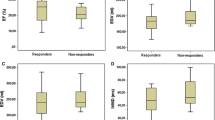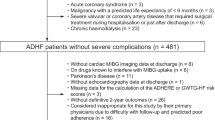Abstract
Objective
123I-metaiodobenzylguanidine (MIBG) scintigraphy is a useful tool for predicting the prognosis in patients with congestive heart failure; however, little is known regarding long-term prognostic evaluations. The aim of this study was to evaluate long-term prognosis in a roughly 10-year period, in dilated cardiomyopathy (DCM) by MIBG imaging, compared to other conventional functional parameters.
Methods
Eighty-six DCM patients (50 ± 14 years of age, 57 males) underwent MIBG imaging, at 15 min and 4 h after tracer injection, from which the delayed heart to mediastinum ratio (H/M) and washout rate (WR) were obtained. The left ventricular ejection fraction (EF) and end-diastolic diameter (LVDd) were also measured by echocardiogram. All patients were followed up for 8–14 years, and the death event was investigated.
Results
Kaplan–Meier curves revealed a poor prognosis only in the group above the third quartile of WR (=50%) (10-year prognosis, 35%); however, there were no statistically significant differences in prognosis among the other 3 groups (10-year prognosis, 75–84%). A Cox hazard univariate analysis selected WR (p = 0.0004), H/M (p < 0.0001), EF (p = 0.0024), and LVDd (p = 0.0189) as significant prognostic indicators. Multivariate analysis revealed the H/M (p = 0.0023) and EF (p = 0.024) to be an independent prognostic predictor. The 10-year prognosis of patients with both WR < 50% and EF > 30%; WR < 50% and EF < 30%; and both WR > 50% and EF < 30% were 89, 71, and 33%, respectively. These three groups were well stratified, significantly (log-rank test: χ 2 = 30.0, p < 0.0001). However, even patients with WR ≥ 50% had few death events after 3 years following MIBG imaging.
Conclusions
The MIBG parameter, delayed H/M or WR combined with the EF is a useful tool for the prediction of a long-term prognosis in DCM, which is superior to MIBG parameters alone. However, patients with WR > 50% but no event in a 3-year follow-up period should undergo an additional MIBG imaging for prognostic prediction.




Similar content being viewed by others
References
Degrado TR, Zalutsky MR, Vaidyanathan G. Uptake mechanisms of meta-[123I]iodobenzylguanidine in isolated rat heart. Nucl Med Biol. 1995;22:1–12.
Imamura Y, Fukuyama T, Mochizuki T, Miyagawa M, Watanabe K. Prognostic value of iodine-123-metaiodobenzylguanidine imaging and cardiac natriuretic peptide levels in patients with left ventricular dysfunction resulting from cardiomyopathy. Jpn Circ J. 2001;65:155–60.
Momose M, Kobayashi H, Iguchi N, Matsuda N, Sakomura Y, Kasanuki H, et al. Comparison of parameters of 123I-MIBG scintigraphy for predicting prognosis in patients with dilated cardiomyopathy. Nucl Med Commun. 1999;20:529–35.
Nakata T, Miyamoto K, Doi A, Sasao H, Wakabayashi T, Kobayashi H, et al. Cardiac death prediction and impaired cardiac sympathetic innervation assessed by MIBG in patients with failing and nonfailing hearts. J Nucl Cardiol. 1998;5:579–90.
Jacobson AF, Senior R, Cerqueira MD, Wong ND, Thomas GS, Lopez VA, et al. Myocardial iodine-123 meta-iodobenzylguanidine imaging and cardiac events in heart failure. Results of the prospective ADMIRE-HF (AdreView Myocardial Imaging for Risk Evaluation in Heart Failure) study. J Am Coll Cardiol. 2010;55:2212–21.
Akutsu Y, Kaneko K, Kodama Y, Li HL, Kawamura M, Asano T, et al. The significance of cardiac sympathetic nervous system abnormality in the long-term prognosis of patients with a history of ventricular tachyarrhythmia. J Nucl Med. 2009;50:61–7.
Nakanishi R, Fujimoto S, Utanohara Y, Takamura K, Inoue A, Yamashina S, et al. Significance of performing 123I-metaiodobenzylguanidine myocardial scintigraphy at different times for the long-term prediction of cardiac events in patients with dilated cardiomyopathy. Nucl Med Commun. 2010;31:488–94.
Lauer MS, Blackstone EH, Young JB, Topol EJ. Cause of death in clinical research: time for a reassessment? J Am Coll Cardiol. 1999;34:618–20.
Budoff MJ, Shaw LJ, Liu ST, Weinstein SR, Mosler TP, Tseng PH, et al. Long-term prognosis associated with coronary calcification: observations from a registry of 25,253 patients. J Am Coll Cardiol. 2007;49:1860–70.
Min JK, Shaw LJ, Devereux RB, Okin PM, Weinsaft JW, Russo DJ, et al. Prognostic value of multidetector coronary computed tomographic angiography for prediction of all-cause mortality. J Am Coll Cardiol. 2007;50:1161–70.
Schenker MP, Dorbala S, Hong EC, Rybicki FJ, Hachamovitch R, Kwong RY, et al. Interrelation of coronary calcification, myocardial ischemia, and outcomes in patients with intermediate likelihood of coronary artery disease: a combined positron emission tomography/computed tomography study. Circulation. 2008;117:1693–700.
Shaw LJ, Raggi P, Schisterman E, Berman DS, Callister TQ. Prognostic value of cardiac risk factors and coronary artery calcium screening for all-cause mortality. Radiology. 2003;228:826–33.
Nishii M, Inomata T, Takehana H, Naruke T, Yanagisawa T, Moriguchi M, et al. Prognostic utility of B-type natriuretic peptide assessment in stable low-risk outpatients with nonischemic cardiomyopathy after decompensated heart failure. J Am Coll Cardiol. 2008;51:2329–35.
Watanabe J, Shiba N, Shinozaki T, Koseki Y, Karibe A, Komaru T, et al. Prognostic value of plasma brain natriuretic peptide combined with left ventricular dimensions in predicting sudden death of patients with chronic heart failure. J Card Fail. 2005;11:50–5.
Kyuma M, Nakata T, Hashimoto A, Nagao K, Sasao H, Takahashi T, et al. Incremental prognostic implications of brain natriuretic peptide, cardiac sympathetic nerve innervation, and noncardiac disorders in patients with heart failure. J Nucl Med. 2004;45:155–63.
Fujimoto S, Inoue A, Hisatake S, Yamashina S, Yamashina H, Nakano H, et al. Usefulness of 123I-metaiodobenzylguanidine myocardial scintigraphy for predicting the effectiveness of beta-blockers in patients with dilated cardiomyopathy from the standpoint of long-term prognosis. Eur J Nucl Med Mol Imaging. 2004;31:1356–61.
Kasama S, Toyama T, Sumino H, Nakazawa M, Matsumoto N, Sato Y, et al. Prognostic value of serial cardiac 123I-MIBG imaging in patients with stabilized chronic heart failure and reduced left ventricular ejection fraction. J Nucl Med. 2008;49:907.
Author information
Authors and Affiliations
Corresponding author
Rights and permissions
About this article
Cite this article
Momose, M., Okayama, D., Nagamatsu, H. et al. Long-term prognostic stratification by a combination of 123I-metaiodobenzylguanidine scintigraphy and ejection fraction in dilated cardiomyopathy. Ann Nucl Med 25, 419–424 (2011). https://doi.org/10.1007/s12149-011-0479-x
Received:
Accepted:
Published:
Issue Date:
DOI: https://doi.org/10.1007/s12149-011-0479-x




